Dendrobium flower: home care
Orchids have long become habitual inhabitants of window sills in apartments and houses. Thanks to their beauty and long flowering, more and more people want to grow them on their own. Among all types of orchids, the most adapted to home growing is dendrobium. What conditions do you need to create a flower for a comfortable living, and how to properly care for it - let's figure it out.
Botanical description of the plant
Orchid dendrobium is a prominent representative of herbaceous perennials of the Orchid family. Homeland plants - tropical forests of Asia, Africa, Indonesia, New Zealand.
This flower belongs to plants with a sympodial type of growth (that is, with many horizontally growing shoots) and can reach a height of 1 m. The stem of the culture is a pseudobulb of a cylindrical shape that forms shoots at the base with rhizome rhizomes.
Photo gallery




















| Root system | Well developed, roots covered with velamen |
| Stem | Cylindrical pseudobulbs |
| Leaf shape | Lanceolate, elongated, elliptical |
| Leaf color | Light green green |
| Inflorescences | Pistiform, with one or more flowers |
| Flower | Large, unisex, with a tubular lip around the column |
| Flower color | Plain, two or three color: pink, yellow, white, lilac, red |
The root system of an exotic beauty is well developed, each root is covered with a spongy multilayer dead tissue - velamen, which is a characteristic feature of almost all epiphytic cultures.
On the stem in order are rather large, ellipsoid, elongated leaves up to 10 cm in length, dark green or green. Peduncles are formed from the axils of the leaves, each of which contains up to 4 flowers with a diameter of 4–8 cm. The flowers have a wide palette of colors, which can be either monophonic or consist of several flowers. There are dendrobiums of white, yellow, lilac, pink, red color. Did you know? A distinctive feature of all dendrobium orchids is the presence on the flower of the so-called lip, which is folded into a tube around a short column.
The main types
There are a large number of varieties of dendrobiums, however, only some species are suitable for home cultivation, of which the most popular are:
- Orchid dendrobium nobile. The second name of the flower is Noble. It has a rather thick fleshy stem, oblong, elliptical, leathery to the touch green leaves and large, bright and extremely fragrant flowers. Dendrobium nobile flowers have an original color: at the base they are creamy white, closer to the edges - lilac or lilac. A white lip with a small edge has a dark lilac spot at the base. The flowering period of the Noble orchid is from January to May.

- Dendrobium paris. It is considered a representative of epiphytic type plants that “settle” on other cultures or spend their whole life or part of it without contacting the soil. In appearance, it is similar to the Noble Orchid and is distinguished by a more fleshy drooping stem, the length of which is 30–40 cm. The leaves of the plant have an elongated shape with a small tip at the end. Single, fairly large flowers with a diameter of 5–8 cm, lilac or pink color with a dark border are formed on the peduncles. A lip of white or amethyst color has a diamond shape. The flowering of Parish dendrobium occurs twice a year: in spring and summer, while the flowers remain on the plant for up to 2 weeks.
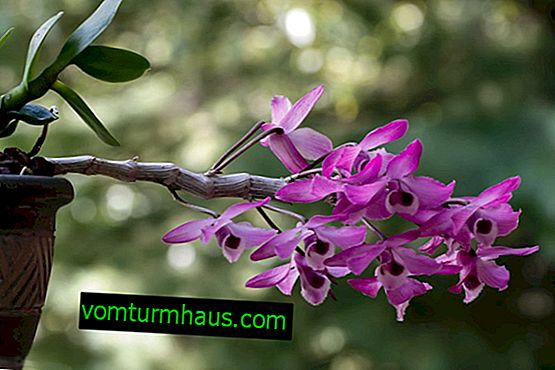
- Dendrobium stardust. A hybrid resulting from the crossing of Unique and Moniliform orchids. The culture has a thin stem up to 0.5 m high, lacental leaves about 8 cm long and up to 3 cm wide. The flowers are large, 4-6 cm in diameter. Up to 5 flowers can ripen at the same peduncle, the color of which varies from light yellow to red-brown, with brown streaks on the lip.

- Orchid Yamamoto. Belongs to a series of tetraploid hybrid cultures grown on the basis of Nobile. A distinctive characteristic of this variety is an upright, neat stem up to 40-50 cm long. During flowering, many small flowers of a wide variety of colors ripen on the stem. The culture is very easy to grow, undemanding to care for, therefore, it is a frequent guest of window sills in apartments or offices.

- Phalaenopsis. Australian large deciduous plant, which has a long, erect, fleshy stem, growing up to 70 cm, and strong leathery leaves up to 10 cm in length. On one peduncle, more than 10 flowers of a rather large size can be formed - 9-10 cm in diameter. The color of this species can be dazzling white, so pink, burgundy, purple-violet. Flowering time is approximately 2 months, from November to January.
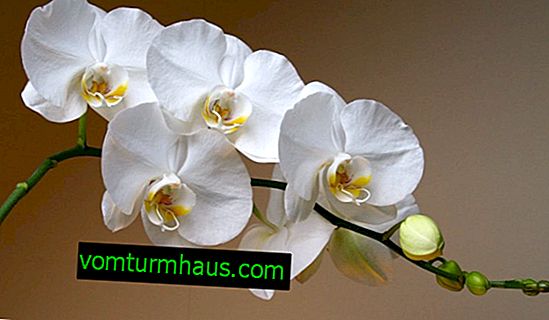
House growing conditions
Exotic beauty has a spectacular and unique appearance, so it requires proper attention. Of course, growing a dendrobium is troublesome, but subject to all the rules of care, the flower will respond with lush and long flowering. Did you know? Bulbs of dendrobiums have the ability to accumulate moisture and use it to feed the plant during a drought. This quality greatly simplifies the care of these orchids.
Lighting
Orchid belongs to photophilous plants, therefore, prefers to live on window sills on the south side of the apartment. However, direct sunlight can be detrimental to the culture. The best option is bright diffused lighting. Therefore, if the flower is grown on the east or west side, he will need an additional light source.

The plant itself will tell you about the amount of illumination, or rather, the color of its foliage. If the leaves become dark green, then it is necessary to increase the amount of light, and if light green - it is recommended to make the dendrobium temporary shade.
Important! It is strictly forbidden to place an orchid in the northern part of the room.
Ventilation
The plant is very sensitive to drafts, which can adversely affect the condition of the whole flower. At the same time, the dendrobium reacts negatively to stagnant air, up to the point that its root system begins to dry out.
To prevent this situation, experts recommend regularly airing the culture or taking the flower out for several minutes in open air, for example, on a balcony or terrace, protecting it from direct sunlight.

Temperature mode
Despite the fact that this orchid is a thermophilic plant, during the period of active growth, it prefers moderate temperatures in the range of 20–25 ° С. Too high temperature indicators, above 30 ° C, can provoke the death of a flower.
Therefore, if it is not possible to control the ambient temperature, you need to increase the humidity level by placing a container of water, an aquarium with fish, an artificial fountain near the pot with an orchid or placing the pot in a tray with water or wet pebbles. Did you know? Cut flowers from an orchid can remain fresh and maintain their beautiful appearance for 2 weeks. In the autumn period, when the plant enters the dormant phase, the temperature at night and day should differ by no more than 10 ° C. It is better to adhere to 18–20 ° С in the daytime, and 8–12 ° С at night.
How to care at home
Since this type of plant belongs to epiphytes that “grow on trees, ” their main enemies are lack of lighting, low humidity, or excessive moisture. All this should be considered when caring for orchids.

Watering
Excessive watering is one of the main negative factors affecting the health of the dendrobium. Culture requires abundant but infrequent watering. A signal to moisture is the drying of the topsoil or moss. In the summer, it is enough to water 2-3 times a week. Excess moisture can cause rotting of the root system, which, in turn, will lead to the death of the flower.
To moisturize, experts recommend using the immersion method. To do this, the container with the plant should be immersed in water for several minutes. You can also practice bottom watering in pallets. Water for humidification should be settled, soft, not cold - a little warmer than the temperature in the room. Read also how to properly and how to water geraniums for plentiful flowering. Such an irrigation scheme must be adhered to throughout the entire period of orchid growth. As soon as leaflets form on the sprouts, the frequency of hydration should be reduced and renewed only after the formation of flower buds. If the mode is not changed, then new shoots will appear instead of flowers.
Spraying
Dendrobium has a positive attitude to regular spraying. They are especially useful for low humidity in the room where the flower lives. However, this plant is sprayed only on hot days, and in winter time additional moistening of the foliage is not required.
Top dressing
In the phase of active growth - from the beginning of flowering to the end of the growth of shoots - for the normal development of the flower, fertilizing should be done using products specially designed for orchids. It is better to combine the application of fertilizers with watering, and the starting and finishing top dressing should be less concentrated than all the intermediate ones.

Feeding agents are recommended to be dissolved in irrigation water, into which the plant is immersed. The optimal frequency of feeding is considered 1 time in 7 days.
Pruning
Orchid pruning is recommended to be carried out exclusively in some cases, indications of which are:
- Too dry, yellowed and shriveled stems - they no longer perform any functions and only take away nutrients from the young.
- Rotten pseudobulbs - their removal prevents the spread of infection throughout the plant.
Important! You can not do pruning when the dendrobium blooms. It is recommended to wait until all the flowers fall.
Transfer
Dendrobium is quite negative about transplantation, as it has a fragile root system that can be damaged during transplantation. It is strictly forbidden to “ted” a plant during its intensive growth. It is better to transplant during the rest of the culture or at the beginning of its growing season, for example, from the second half of February to the beginning of March.

For transplantation, it is necessary to choose a transparent, glass or plastic container, the size of which corresponds to the size of the roots and is 1-2 cm larger in diameter than an earthen lump. A mixture consisting of equal parts of chopped pine bark, chopped sphagnum moss and charcoal is an excellent substrate for an orchid. It is also recommended to add some cut fern roots to the soil.
The process of transplanting orchids will not cause difficulties if you follow this algorithm:
- at the bottom of the pot you need to put a few pebbles that will serve as a kind of weighting agent;
- pour a drainage layer consisting of expanded clay, pebbles or polystyrene into the tank;
- sprinkle some coarse soil on top;
- shift dendrobium from an old pot to a new one by transshipment method;
- sprinkle the plant with the rest of the soil;
- water the culture and place in a well-lit place.
Video: How to transplant an orchid
Breeding
At home, you can “spread” a flower in several ways. Dendrobium propagates in different ways - both with the help of children or cuttings, and by dividing the bush.
Kids
Aerial shoots, which are formed in the axils of leaves from the vegetative buds, are the so-called children that can be used to propagate orchids. It should be noted that the shoots located in the lower part of the stem do not fulfill the role of children.

Reproduction by children includes several stages:
- Baby branch. On the stem, select a baby whose shoot formed the first leaves, and the roots in this case reached a length of more than 5 cm.
- Landing in the ground. Separated children should be placed in a container with a soil mixture, which includes a small fraction of pine bark and moss. Moisten the soil liberally.
- Seedling care. Place the pot with planting material in a warm place, where the temperature varies between 22–25 ° С. When the growth of children begins, they should be regularly watered, like adult plants.
Also learn how to propagate balsam, bougainvillea and royal geranium at home.
Cuttings
Another method of propagation of orchids is cuttings. However, this method is only suitable for deciduous species of dendrobium.
Cuttings are carried out as follows:
- Cut off pseudobulbs from the main plant and divide them into several parts with 2-3 internodes.
- Place such divided cuttings in a plastic bag filled with moist moss to form roots. In this case, the package must be placed in a warm, well-lit place.
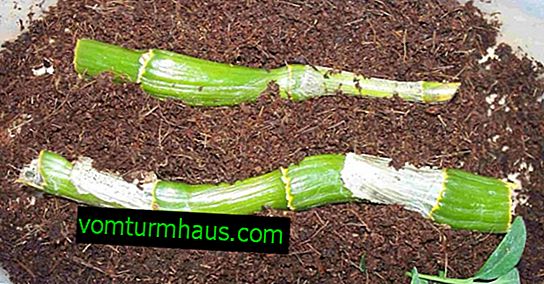
- After the appearance of the roots (after about 2-3 weeks), plant the cuttings in a substrate from the bark and sphagnum and wait for the emergence of young shoots.
With this method of reproduction, the first flowering of the crop will begin in the 2nd – 3rd year.
We recommend reading how to plant indoor flowers in a pot.
Dividing the bush
The simplest and most affordable method of propagating orchids is the division of the bush. Experts recommend holding an event after flowering of a crop during its transplantation.
To do this, you must:
- Extract the plant from the pot.
- Gently untangle the root processes.
- Place the bush on a hard surface and use a sharp knife to cut it into several parts so that each gets at least 2 pseudobulbs and as many young shoots.

- Sprinkle slices with powdered activated carbon to prevent root decay.
- Form the formed parts of the plant in separate containers and provide them with appropriate care.
Growing difficulties
Special difficulties in the cultivation of orchids in flower growers does not arise provided that they are properly taken care of. However, sometimes even experienced craftsmen may have some difficulties.
Did you know? The appearance of small sticky spots on the leaves of the dendrobium is a natural phenomenon. The fact is that under natural conditions, to attract insects, in particular ants that protect the plant, the orchid secretes sweet, sticky droplets.
Why does not bloom
The most common problem when growing dendrobium is the lack of flowering. This may be due to the fact that the flower did not go through the phase of complete rest, so it must be placed in a cooler place and reduce the amount of moisture, thereby artificially creating a rest period.
In addition, the reasons that the culture does not bloom may include:
- Lack of sufficient lighting, or, conversely, too much light and a hot microclimate.
- Not enough air in the room. The flower prefers fresh air, so it should be systematically ventilated or carried out into the open. Such measures will allow renewing the strength of the plant and give it an influx of new energy.
- Stress for a plant associated with its rearrangement or relocation. In such cases, it is necessary to give the culture time to adapt and provide it with the necessary care.

If the flower has wintered well, has not been stressed, has passed the dormant stage, then poor lighting will still be the main reason for the lack of flowering. It is recommended to increase the plant's daylight hours by placing a pot of orchid in a brighter place or by installing additional light sources near it.
Also learn what to do if geranium and anthurium do not bloom.
Diseases and Pests
Illiterate orchid care can cause various diseases, the signs of which are:
- The curvature of young shoots, the leaves are folded into an "accordion". This indicates irregular watering during the growing season. To solve the problem, you should organize uniform hydration.
- Souring of the soil and rotting of the roots indicates excessive watering. In such cases, you need to transplant the culture into a new soil.
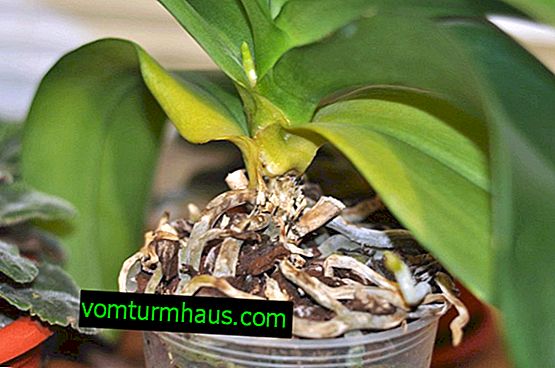
- Sharp yellowing of the sheets and falling flowers. The most likely cause is rotting of the root system. It is recommended to transplant the orchid in another soil, removing all damaged roots.
- An instant discoloration of the stem is a sign that the plant has undergone a fungal or bacterial infection.
We advise you to read how to deal with pests and diseases of the monstera.
In addition to diseases, dendrobium can be attacked by various parasites and pests.
The following facts signal them:
- sticky mucus appeared on the leaves and the trunk - the harmful effects of the scale;
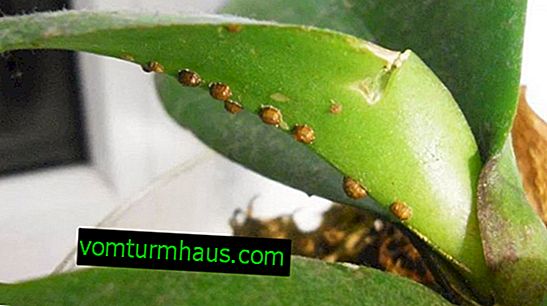
- the presence of a transparent web on greens - the action of a spider mite;

- yellowing of leaves, brown spots on them - thrips.

In order to rid the orchid of parasites, it is necessary, firstly, to increase the humidity level in the room, and secondly, to treat the foliage with insecticidal preparations.
Orchid dendrobium - an amazingly original plant, which will become a real decoration of the home interior. However, in order for the culture to please with lush and prolonged flowering, it needs to organize comfortable living conditions, as well as provide a good rest during the dormant period.














